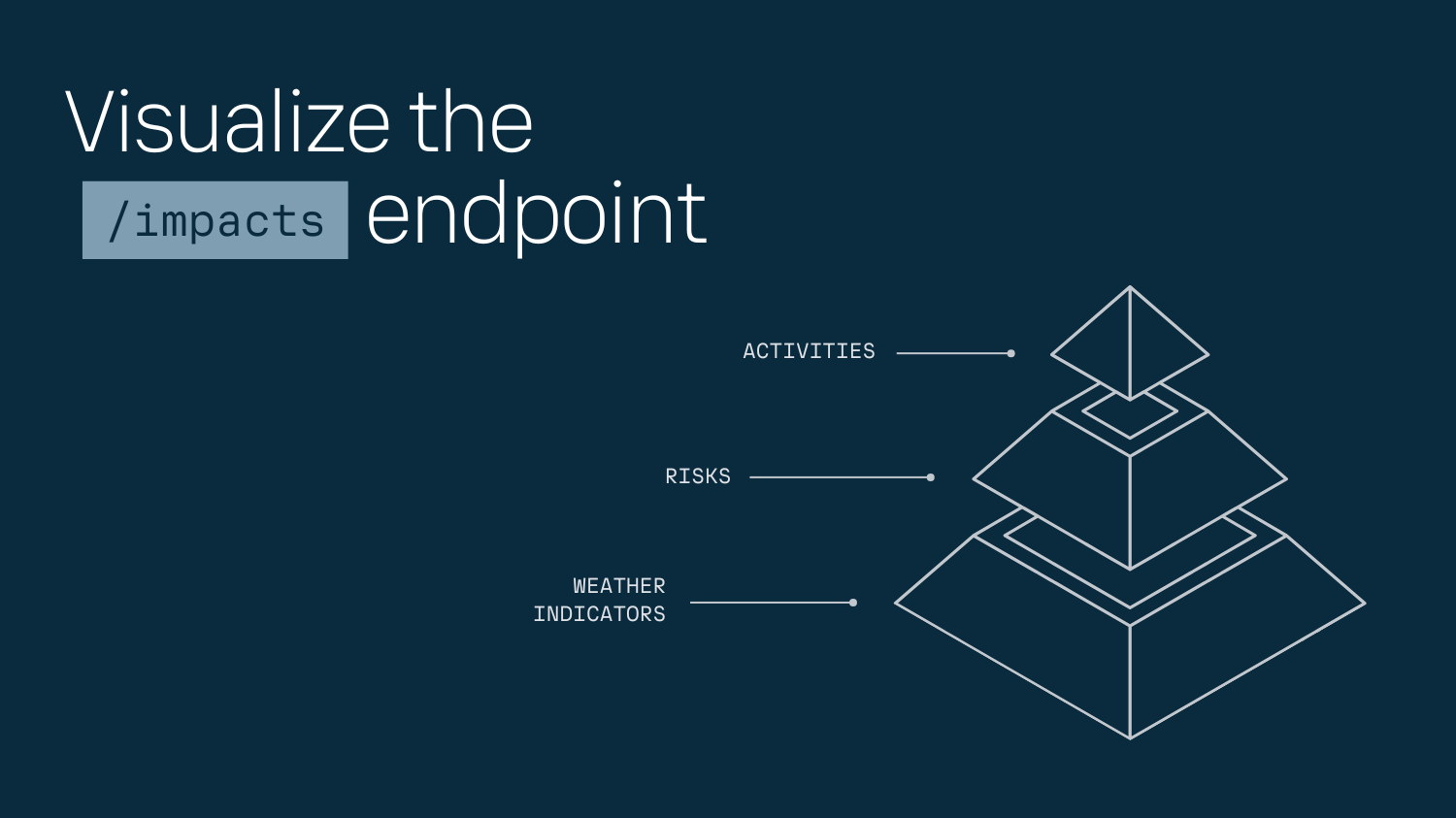Gain clarity on weather impacts for specific activities with two data-packed features of the Weather API and Maps subscriptions.
Bridging the gap between weather data and operational action is not only possible; it's necessary. Read on for our latest game-changing solutions, available with the Weather API and Maps subscription.
Rapidly changing weather conditions pose critical challenges for industries dependent on outdoor operations, logistics, and maritime activities. While informative, users often rely on general forecasts that fall short of providing context-specific, actionable insights. Ambiguities in weather terminology, such as vague probabilities or broad forecast periods — like, for example, “What does a 50% chance of rain mean?”— can leave decision-makers guessing about potential impacts. This lack of clarity often leads to safety hazards, disruptions, and inefficiencies.
Even with detailed forecasts, businesses often struggle to understand how predicted weather will impact them. This disconnect between weather data and its impact on operations creates safety, planning, and overall efficiency gaps.
About the /impacts endpoint
Xweather’s /impacts endpoint is designed around a structured analysis model—think of it as a pyramid. This approach translates complex weather data into actionable insights tailored to applications like outdoor recreation, trucking, maritime shipping, and small craft navigation.
At the pyramid's base are weather indicators—key data points such as wind speed, temperature changes, lightning proximity, road surface conditions, and rainfall rates—which form the foundational layer for assessing specific weather conditions.
In the middle tier are risks, which group multiple weather indicators to create comprehensive risk profiles. Examples include wind, rain, lightning, and severe storm risks, each incorporating relevant weather indicators. For instance, severe storm risk considers nearby lightning activity, hail threats, and active severe weather watches and warnings.
At the top of the pyramid are the activities, where aggregated risks are analyzed to deliver a holistic assessment tailored to the use case. This tier enables users to understand how combined risks impact their operations and make informed decisions.

Think of the /impacts endpoint as a pyramid.
For example, outdoor activities might focus on lightning risk using recent strikes and forecasts, while trucking might consider rollover risk with wind data and road weather analytics. This approach helps plan and manage risks effectively.
Accessing /impacts with the weather API
The /impacts endpoint is consistent with other Xweather API endpoints, making integration straightforward. The query structure is as follows:
:activity refers to any of the predefined activities, such as:
general(outdoor activities)roadway_trucking(shipping via tractor trailer)maritime_large_vesselmaritime_small_craft
:location is consistent with supported Xweather API place formats (see all supported places here).
"For instance, if we want to check general conditions to decide whether to plan a beach day in Miami, FL, we would query: https://data.api.xweather.com/impacts/general/miami,%20fl?client_id={client_id}&client_secret={client_secret}
The /impacts endpoint also supports filters such as minseverity# (where # ranges from 1 to 5) to limit results to specific minimum risk levels. By default, the API uses minseverity1 or ‘minimal’ risk and higher, making it easy to focus on the most relevant data. Here's a breakdown of the impact severities:
1 - Minimal impacts
2 - Low impacts
3 - Moderate impacts
4 - Significant impacts
5 - Major impacts
Note that a severity of 0 can be used in order to see the breakdown of all the risks for the particular activity.
Route-based assessments
For users needing route-based assessments — a passed list of locations and times you expect to be at those locations — /impacts also supports route impact tracking with the following parameters:
The route action allows users to gather impacts along a specified route. These routes are passed as a GeoJSON LineString in the body of a POST request, providing comprehensive impact tracking along custom paths.
Delivering clear insights with the Phrases API
Through the Weather API, /impacts provides comprehensive, tailored assessments, effectively communicating these insights to various audiences. In contrast, the LLM-based Phrases API currently offers three endpoints — /impacts, /conditions, and /alerts — that use and build upon the corresponding endpoints in the Weather API by translating complex impact data into clear, easy-to-understand text responses customized for specific needs. This ensures that weather impact information is communicated in a way any audience can understand and act on.
To access the Phrases API with /impacts data, the query format is as follows:
:activity refers to any of the predefined activities, such as:
general(outdoor activities)truckingdriving(consumer vehicles)maritime-shippingmaritime-small-craft
:location can be any standard Xweather API place format, such as latitude/longitude or city/state.
The Phrases API also supports additional query parameters:
stream: true/false, defines whether to stream the LLM response as generated or wait for the complete response.units: metric, imperial, or both (default).language: either as a parameter or via the standard HTTP language header.min_severity: specifies the minimum impact level (1-5) to include information for:1 - Minimal impacts
2 - Low impacts
3 - Moderate impacts
4 - Significant impacts
5 - Major impacts
For example, a maritime shipping center might use the /impacts endpoint for advanced weather-enhanced routing across seas. At the same time, the ship captain needs actionable real-time updates along their route, whether through onboard displays or text-to-speech announcements. This is where the Phrases API shines, turning complex data into straightforward messages: “Expect gusty winds exceeding 25 mph along your route for the next two hours. Take caution.” This approach ensures that strategic planners and frontline staff receive relevant, accessible insights.
Bridge the gap between data and action with targeted weather updates
Imagine a trucking company planning for potential risks across regions. The /impacts endpoint provides a comprehensive analysis of weather-related risks like hydroplaning. The Phrases API then converts these risks into real-time alerts that drivers can act on, bridging the gap between strategic data and on-the-ground safety measures.
Built for the future
While the /impacts endpoint’s initial launch supports a broad set of activities, we look forward to collaborating with clients to expand its capabilities and refine the Phrases API. This client-focused approach ensures our solutions remain adaptable, relevant, and responsive to evolving industry needs.
Contact our Sales Team with supported response requests for the /impacts endpoint or the Phrases API. You can also test the Phrases API and /impacts endpoint for yourself with a free 30-day trial.
